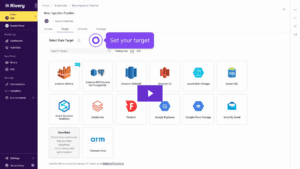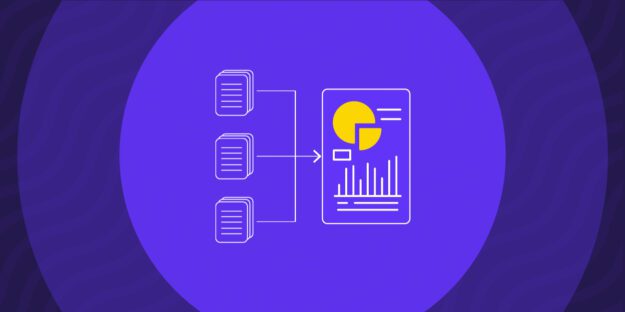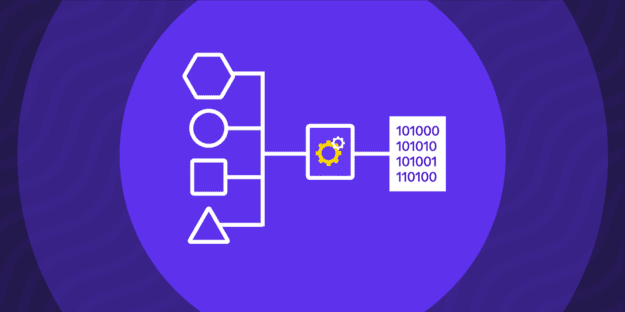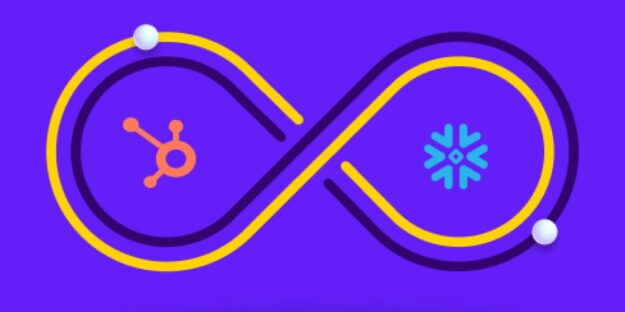Organizations today face the challenge of efficiently processing and managing vast amounts of data from diverse sources. This is where data ingestion architecture plays a pivotal role.
Data ingestion architecture refers to the framework and processes designed to capture, collect, and ingest data from various systems into a centralized repository or data lake. It provides the foundation for seamless and reliable data integration, allowing organizations to harness the power of their data for informed decision-making and valuable insights.
The importance of data ingestion architecture lies in its ability to handle the ever-increasing volume, velocity, and variety of data. With the proliferation of IoT devices, social media platforms, and other digital sources, organizations must be equipped to handle real-time data streams, structured and unstructured data, and data in different formats.
Scroll down to read how to successfully navigate data ingestion in 2024 using some of today’s data ingestion best practices.
The Evolution of Data Ingestion
In the early days, data ingestion primarily relied on batch processing techniques. Data was collected and stored in batch files, often transferred through FTP or other file transfer protocols. The ingestion process was manual and time-consuming, limiting real-time data availability and analysis.
With the rise of enterрrise integration patterns, ESBs emerged as a popular approach in the early 2000s. ESBs provided a centralized hub for data ingestion, allowing for connectivity, transformation, and routing of data between various systems. This enаbled more efficient and scalable data ingestion across the enterprise.
The advent of big data technologies brought about significant changes in data ingestion. Data lakes emerged as a central repository for storing and processing vast amounts of raw and diverse data. Ingestion frameworks, such as Apache Flume and Apache NiFi, were developed to handle data ingestion from various sources and provide scalable, real-time data processing capabilities.
Modern data ingestion architectures have shifted towards streaming and event-driven paradigms. Technologies like Apache Kafka and Apache Pulsar enable real-time, continuous data ingestion and processing, allowing organizations to capture and react to events as they occur. This evolution has been driven by the need for real-time analytics, machine learning, and actionable insights.
Current Trends in Data Ingestion Architecture
There is a growing emphasis on real-time data ingestion and processing. Organizations are adopting streaming technologies like Apache Kafka, Apache Pulsar, and AWS Kinesis to enable the capture and analysis of data as it is generated. This trend enables faster insights, immediate action, and improved decision-making.
Event-driven architectures are gaining traction in data ingestion. Instead of traditional batch processing, event-driven approaches allow data to be ingested and processed based on specific events or triggers. This enables more efficient and targeted data ingestion, reducing latency and enabling real-time reactions to critical events.
As expected, cloud computing has transformed data ingestion architecture. Organizations are leveraging cloud-based data ingestion services, such as AWS Data Pipeline, Azure Data Factory, and Google Cloud Dataflow, to securely and efficiently ingest data from diverse sources. Cloud-native architectures offer scalability, flexibility, and cost-effectiveness for data ingestion processes.
Core Components of Data Ingestion Architecture
Contemporary data ingestion architecture comprises several crucial components, like data sources, data ingestion layers, data transformation and enrichment, etc. Streaming, one of the core elements in the data ingestion architecture, is ideal for capturing and processing data in real-time, enabling immediate insights and actions. It is the perfect operational method for time-sensitive applications that require up-to-date information and rapid response to events.
Batch processing, another pillar of a data ingestion strategy, is suitable for handling larger volumes of data that can be processed in batches. It is effective for non-real-time or offline processing scenarios where immediate analysis is unnecessary.
Data sources are practically the systems, applications, devices, or platforms from which data originates. Databases, APIs, sensors, social media platforms, IoT devices, and log files are all data sources.
Data ingestion layers consist of tools, frameworks, or platforms responsible for capturing and collecting data from various sources. It may include components like connectors, adapters, or agents that facilitate data extraction and ingestion. Apache Kafka, Apache NiFi, AWS Kinesis, and Azure Event Hubs are some of the most popular technologies today.
The Importance of Other Core Elements of Data Ingestion Archicture
Data storage involves storing the ingested data for further processing and analysis. It can include data lakes, data warehouses, or other storage systems that provide scalability, fault-tolerance, and efficient querying capabilities.
Metadata management encompasses capturing and organizing ingested data. It helps with data discovery, governance, and understanding its context and characteristics.
The monitoring and alerting processes focus on overseeing the data ingestion pipeline’s health, performance, and data quality. They include monitoring tools and dashboards that provide real-time insights into the ingestion process, detect anomalies, and trigger alerts or notifications in case of issues or failures.
Data governance and security components ensure compliance, privacy, and protection of ingested data. This includes access controls, encryption, data anonymization, auditing, and compliance frameworks to enforce data government policies and standards.
Real-Time Streaming
Real-time data streaming is highly significant in today’s data-driven landscape for the following reasons:
Immediate insights and actions: Real-time streaming allows organizations to gain instant insights and make timely decisions based on up-to-date information. It enables the detection of patterns, anomalies, and opportunities as data is generated, leading to faster and more informed actions.
Enhanced operational efficiency: By continuously monitoring and analyzing data in real time, organizations can identify and address operational inefficiencies promptly. This proactive approach improves resource allocation, reduces downtime, and enhances overall operational efficiency.
Improved customer experience: Real-time streaming enables organizations to provide personalized and seamless customer experiences. By analyzing customer data in real time, organizations can respond promptly with targeted offers, recommendations, and support, leading to higher customer satisfaction and loyalty.
Predictive and prescriptive analytics are advanced techniques used to analyze streaming data continuously. This helps organizations identify trends, make predictions, and optimize processes in real-time, enabling proactive decision-making and optimization.
Best Practices and Tools for Implementing Real-Time Data Ingestion
Following real-time data ingestion best practices allows organizations to:
- Optimize their workflows
- Understand data requirements
- Choose a suitable streaming platform
- Validate and cleanse data
- Ensure appropriate security and compliance measures
- Set up monitoring and alerting systems
Apache Kafka, Apache Pulsar, AWS Kinesis, Google Cloud Pub/Sub, and Confluent Platform are some of the recommended tools. They provide scalable, fault-tolerant, and high-throughput capabilities for real-time data ingestion and processing.
Consider factors like performance, durability, scalability, and integration when selecting a streaming platform. Implement data validation, encryption, access controls, and authentication measures to protect data. Monitor data throughput, latency, and system metrics to identify and address issues promptly.
Batch Processing
Batch processing plays a crucial role in data ingestion, particularly when dealing with large volumes of data. It involves collecting and processing data in predefined batches or groups, as opposed to real-time or streaming data processing. Batch processing offers several advantages, including the ability to handle large data sets efficiently, perform complex data transformations, and optimize resource utilization.
The following strategies can help with efficient and scalable batch data processing:
- Data partitioning: Divide data into smaller partitions or chunks to enable parallel processing. This allows for distributing the workload across multiple processing units, improving overall processing speed and efficiency.
- Distributed processing: Use distributed computing frameworks, like Apache Hadoop or Apache Spark, to distribute data and computations across a cluster of machines. This enables horizontal scalability and faster processing by leveraging the combined resources of multiple nodes.
- Data compression: Compressing data reduces storage requirements and improves the overall processing speed. Implementing compression techniques, such as using file formats like Parquet or ORC, helps to optimize the batch processing performance.
- Resource optimization: Optimize resource allocation by dynamically allocating computational resources based on the workload. This can involve techniques like auto-scaling or resource pooling, ensuring efficient utilization of available resources while accommodating varying data processing demands.
Data Ingestion Tools and Technologies
The field of data ingestion has witnessed significant advancements, with various tools and technologies emerging to handle the ever-increasing volume, variety, and velocity of data. There are a lot of data ingestion tools you can use like:
Rivery – It offers a complete data ingestion framework that can work with any source. It allows you to set alerts, change your data volume, enable reverse ELT, or talk to a professional should you encounter any problems.
Apache Kafka is a distributed streaming platform that provides scalable and fault-tolerant data ingestion capabilities. It enables real-time data streaming and supports high-throughput, low-latency data ingestion from multiple sources.
Apache NiF is also a powerful data integration and ingestion tool that offers a visual interface for designing data flows. It enables efficient data routing, transformation, and delivery across diverse systems and supports real-time and batch data ingestion.
AWS Glue is a fully managed extract, transform, and load (ETL) service provided by Amazon Web Services (AWS). It simplifies the process of ingesting, preparing, and transforming data from various sources into a data lake or data warehouse for analysis.
Google Cloud Dataflow is a managed service on the Google Cloud Platform (GCP) that provides a unified programming model for both batch and streaming data processing. It offers scalability, fault tolerance, and ease of use for data ingestion and processing tasks.
Useful Guidelines on Selecting the Right Tools
The efficacy of data ingestion depends on using the right tools for the job. Consider the following guidelines before you employ a data ingestion tool.
- Scalability: Evaluate the scalability requirements of your data ingestion workflows and choose tools that can handle the expected data volume and velocity while ensuring efficient processing.
- Data sources and formats: Assess the types and formats of data sources you need to ingest, ensuring that the selected tools support the required data sources and can handle diverse data formats.
- Integration capabilities: Consider the compatibility of the tools with your existing data infrastructure and ecosystem. Look for tools that offer seamless integration with your data storage, processing, and analytics systems.
- Ease of use: Evaluate the usability and learning curve associated with the tools. Consider tools with intuitive interfaces, visual design capabilities, and comprehensive documentation to streamline the data ingestion process.
- Reliability and support: Consider the reliability, fault tolerance, and support options provided by the tools and vendors. Choose tools with robust error handling, monitoring, and troubleshooting features.
Scalability and Performance Optimization
To ensure scalability in data ingestion architecture, use distributed processing and horizontal scaling for parallel processing and increased capacity. Additionally, ensure the implementation of data partitioning to distribute workload and prevent bottlenecks. Employing auto-scaling mechanisms to adjust resources based on workload demands Is also a good idea.
For optimizing data ingestion performance, it’s best to use data compression to reduce network bandwidth and improve efficiency. Ensure to employ batch processing to minimize overhead and improve efficiency. Don’t forget to apply data filtering to eliminate irrelevant data before ingestion, as well as implement buffering and caching to enhance performance and reduce data retrieval needs.
Security and Compliance Considerations
Data ingestion isn’t without its challenges, such as the following:
Data breaches: Inadequate security measures during data ingestion can expose sensitive data to unauthorized access or breaches.
Data privacy: Compliance with data privacy regulations, such as GDPR or CCPA, requires careful handling of personal information during data ingestion.
Data governance: Ensuring proper data governance practices, including data classification and access controls, is crucial for maintaining security and compliance.
When it comes to the niche’s best practices, there are several top-notch applications. This includes ensuring data security and regulatory compliance in data ingestion by implementing end-to-end encryption for secure data transmission and storage.
Use strong access controls, such as role-based access control (RBAC) and user authentication, to restrict data access to authorized individuals. Apply data masking or anonymization techniques to protect sensitive data by substituting actual values with pseudonyms or obscured representations.
Successful Data Ingestion Case Studies
Several renowned brands have implemented advanced data ingestion architecture, resulting in significant positive impacts on data management and business operations.
Netflix, for example, employs a robust data ingestion architecture to collect and process vast amounts of user viewing data in real-time. This enables personalized recommendations, content optimization, and data-driven decision-making, enhancing user experience and driving business growth.
Another industry giant, Uber, utilizes a sophisticated data ingestion strategy to collect and analyze real-time data from its ride-hailing platform. This enables dynamic pricing, efficient route optimization, and real-time driver allocation, improving customer satisfaction and operational efficiency.
Future Trends in Data Ingestion
Emerging trends in data ingestion are revolutionizing the way organizations handle data. Real-time streaming is gaining prominence, allowing for instant processing and analysis of streaming data, enabling faster insights and decision-making.
Hybrid cloud integration is on the rise, with data ingestion tools evolving to seamlessly integrate data from on-premises systems and diverse cloud platforms, providing a unified and scalable solution. The proliferation of IoT devices necessitates efficient data ingestion mechanisms that can handle the velocity and volume of IoT-generated data, facilitating real-time analytics and actionable insights.
Additionally, data governance and compliance are becoming paramount, leading to stricter controls, encryption techniques, and auditing mechanisms to ensure data privacy and regulatory adherence.
The Final Say
A well-designed data ingestion architecture is the foundation for unlocking the full potential of your data. By embracing the emerging trends and implementing advanced techniques in data ingestion, organizations can harness the роwer оf real-time streaming, hybrid cloud integration, IoT data, and robust data governance.
It’s time to seize the opportunity and leverage the powerful data ingestion strategies available to you. By doing so, you can ensure seamless data collection, enhance data management capabilities, drive informed decision-making and gain a competitive edge.
Minimize the firefighting. Maximize ROI on pipelines.





